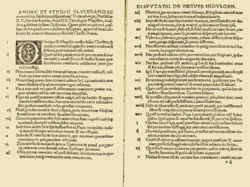| Waldensians | |
|---|---|
 Waldensian symbol Lux lucet in tenebris ("A light shines in the darkness") | |
| Classification | Proto-Protestant |
| Orientation | Reformed |
| Theology | Theology of Peter Waldo and other Waldensian theologians, nowadays also that of John Calvin and other Reformed theologians |
| Region | Italy, Switzerland, France, Germany, Argentina, United States, Uruguay, and elsewhere |
| Founder | Peter Waldo |
| Origin | c. 1173 Lyon, Kingdom of Burgundy-Arles in the Holy Roman Empire (now France) |
| Separated from | Catholic Church |
| Part of a series on the |
| Reformation |
|---|
 |
| Protestantism |
The Waldensians, also known as Waldenses (/wɔːlˈdɛnsiːz, wɒl-/), Vallenses, Valdesi, or Vaudois, are adherents of a church tradition that began as an ascetic movement within Western Christianity before the Reformation. Originally known as the Poor of Lyon in the late twelfth century,[1][2][3] the movement spread to the Cottian Alps in what is today France and Italy. The founding of the Waldensians is attributed to Peter Waldo, a wealthy merchant who gave away his property around 1173,[4][2] preaching apostolic poverty as the way to perfection.
Waldensian teachings came into conflict with the Catholic Church and by 1215 the Waldensians were declared heretical, not because they preached apostolic poverty, which the Franciscans also preached, but because they were not willing to recognize the prerogatives of local bishops over the content of their preaching, nor to recognize standards about who was fit to preach. Pope Innocent III offered the Waldensians the chance to return to the Church, and many did, taking the name "Poor Catholics".[5] However, many did not, and were subjected to intense persecution and were confronted with organised and general discrimination in the following centuries. In the sixteenth century, the Waldensians were absorbed into the Protestant movement, under the influence of early Swiss reformer Heinrich Bullinger.
In some aspects the Waldensians of the Middle Ages could be seen as proto-Protestants, but they mostly did not raise the doctrinal objections characteristic of sixteenth-century Protestant leaders.[6] They came to align themselves with Protestantism: with the Resolutions of Chanforan on 12 September 1532, they formally became a part of the Calvinist tradition. They are members of the Community of Protestant Churches in Europe and its affiliates worldwide. They were nearly annihilated in the seventeenth century.
The main denomination within the movement was the Waldensian Evangelical Church, the original church in Italy. In 1975, it merged with the Methodist Evangelical Church to form the Union of Methodist and Waldensian Churches—a majority Waldensian church, with a minority of Methodists.[7][8] Another large congregation is the Evangelical Waldensian Church of Río de la Plata in Argentina, Paraguay, and Uruguay.[9][10]
Congregations continue to be active in Europe (particularly in the Piedmont region of Northern Italy), South America, and North America. Organizations, such as the American Waldensian Society,[11] maintain the history of the movement and declare their mission as "proclaiming the Christian Gospel, serving the marginalized, promoting social justice, fostering inter-religious work, and advocating respect for religious diversity and freedom of conscience."[12]
- ^ Cite error: The named reference
Macy1984was invoked but never defined (see the help page). - ^ a b Weber, N. (1912). "Waldenses". Catholic Encyclopedia. New Advent. Retrieved 28 January 2019.
The real founder of the sect was a wealthy merchant of Lyons who in the early documents is called Waldes (Waldo) ... On the feast of the Assumption, 1176, he disposed of the last of his earthly possessions and shortly after took the vow of poverty.
- ^ "A History of the Waldensians".
- ^ "Waldenses". Encyclopaedia Britannica. Retrieved 28 January 2019.
little is known with certainty about the reputed founder, Valdes (also called Peter Waldo, or Valdo). As a layman, Valdes preached (1170–1176) in Lyon, France
- ^ E. Cameron, Waldenses: Rejection of the Holy Church in Medieval Europe (Oxford, 2000), pp. 49–62
- ^ Cameron 2000, pp. 264–284
- ^ "Patto di integrazione globale tra le chiese metodiste e valdesi". Chiesa Evangelica Valdese – Unione delle chiese Metodiste e Valdesi. Archived from the original on 23 September 2015. Retrieved 23 March 2014.
- ^ "Per un patto tra la Chiesa Assemblee di Dio e la Chiesa valdese" (PDF). 20 September 2009. Archived from the original (PDF) on 23 September 2015. Retrieved 23 March 2014.
- ^ "Quienes somos – IEVRP" (in Spanish). Retrieved 9 April 2019.
- ^ "South America". www.waldensian.org. Retrieved 9 April 2019.
- ^ "American Waldensian Society". Retrieved 26 February 2014.
- ^ Stroud, James Edward (October 2011). The Knights Templar & the Protestant Reformation. Xulon Press. p. 70. ISBN 978-1-61904-906-2.